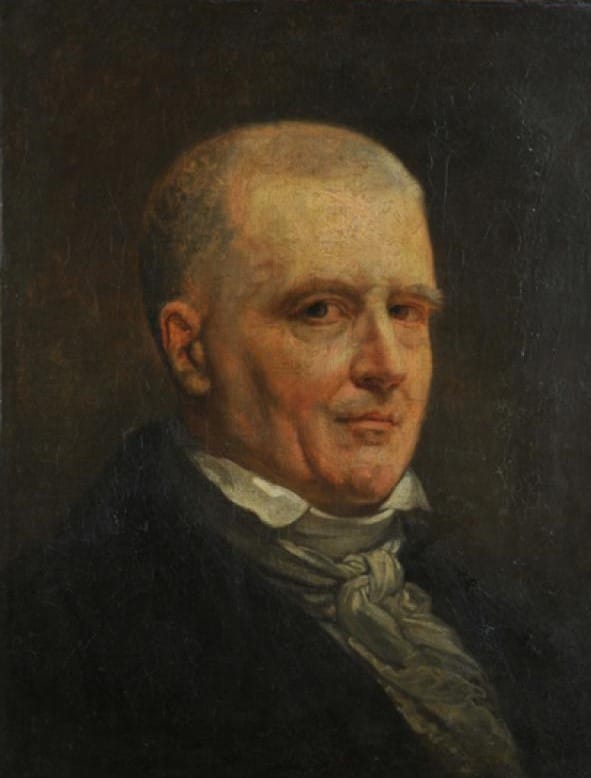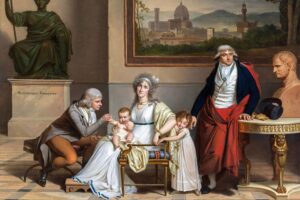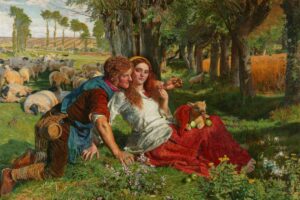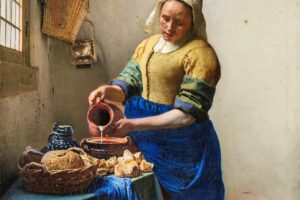By Jean-Honoré Fragonard, around 1750
Imagine a sunny afternoon outdoors, filled with laughter, teasing, and the happy chaos of a favorite game. That’s exactly what Jean-Honoré Fragonard brings to life in his painting Blind Man’s Buff. Created around 1750, this charming artwork perfectly captures the Rococo style, known for its playful elegance, romantic themes, and scenes full of joy.
A Lively Game in a Garden
In this delightful painting, we join a young woman playing the classic game of “blind man’s buff,” where one person wears a blindfold and tries to catch their friends. But in Fragonard’s hands, it’s more than a simple game—it becomes a joyful symbol of love and flirtation.
Meet the Main Characters
- The Blindfolded Lady: At the center is a graceful young woman, elegantly dressed in soft pink, blue, and white fabrics. Her eyes are covered with a white blindfold, topped by a stylish straw hat. Her arms are stretched out, carefully feeling her way forward, totally caught up in the excitement.
- The Playful Young Man: Right behind her stands a young man dressed in earthy colors. His face lights up with a mischievous smile as he gently teases or guides her, clearly enjoying this playful moment.
- Charming Putti: Adding magic and symbolic sweetness to the scene are two delightful little putti—cherub-like figures often representing love and innocence. One putto lies on the ground, happily reaching out towards the dangling cord. The other peeks out shyly from behind greenery. Their playful presence reminds us that this moment is about love, joy, and the sweet innocence of playful romance.
The Enchanting Garden
Fragonard places the scene in a beautiful, lush garden full of life and delicate details:
- Blossoms and Greenery: The background bursts with lush greenery and vibrant pink roses. A large tree with twisting branches provides cool shade and natural beauty, framing the playful scene perfectly.
- Romantic Architecture: Behind the figures, we catch a glimpse of elegant garden architecture, perhaps a charming trellis or a hidden gazebo, adding depth and elegance.
- Rustic Details and Music: On the right, rustic elements—like woven baskets, leaning boards, and a tambourine—suggest music, festivities, and a day filled with leisurely fun.
More Than a Game
Fragonard’s painting isn’t simply about people playing outdoors. It’s also about the gentle dance of romance. The blindfold symbolizes how love is often playful, unexpected, and surprising. Through the smiling faces and charming putti, the artist invites us to share this moment of carefree joy, reminding us that sometimes the sweetest connections happen when we least expect them.
This enchanting scene captures the heart of Rococo charm, celebrating youthfulness, romance, and the delight found in life’s playful moments.
About Artist

Jean-Honoré Fragonard (1732–1806) was a French painter and printmaker who is considered one of the leading figures of the Rococo art movement. His style is a vibrant and fluid expression of the late Rococo, known for its lightheartedness, sensuality, and free-flowing brushwork. Unlike his contemporary Boucher, whose work could sometimes feel more formal, Fragonard’s paintings have a spontaneous and energetic quality that perfectly captured the spirit of the French aristocracy on the eve of the revolution.
Artistic Style and Legacy
Fragonard was a student of François Boucher, and he inherited his master’s love for mythological and pastoral themes. However, Fragonard’s style is more dynamic and painterly, with a liveliness all his own. His work is characterized by:
- Energetic Brushwork: His brushstrokes are visible and expressive, creating a sense of movement and spontaneity.
- Lush, Luminous Color: He used a rich and glowing palette, with shimmering whites, rose, and gold.
- Playful Sensuality: He often depicted scenes of romantic trysts, playful games, and idyllic moments of love, with a light and often erotic touch.
Fragonard’s art fell out of fashion during the Neoclassical period, which favored more serious, moralizing subjects. He died in obscurity, but his reputation was revived in the 19th century, and he is now celebrated as a master of the Rococo.
Artwork Profile
All of the paintings you mentioned are indeed by Jean-Honoré Fragonard. They are excellent examples of his style and a testament to his genius.
- The Swing (c. 1767): This is arguably Fragonard’s most famous painting and a quintessential work of the Rococo period. It depicts a young woman on a swing, with her suitor hiding in the bushes below, catching a glimpse of her as she kicks off her shoe. The lush, overgrown garden, the playful sensuality, and the charming narrative make it an icon of the era.
- The Lover Crowned (c. 1771-1772): Part of a famous series known as “The Progress of Love,” this painting shows a young woman crowning her lover with a wreath of flowers. The scene is filled with a sense of joyous, unrestrained romance.
- The Musical Contest (c. 1754): An early work from his Italian period, it shows a group of young people engaged in a musical game, demonstrating his early interest in playful social scenes.
- The Shepherdess (c. 1760): A charming example of his pastoral scenes, it depicts an idealized country girl in a beautiful, natural setting.
- Blind Man’s Buff (c. 1750-1752): Fragonard painted a few versions of this popular game. The one in the National Gallery of Art is a lively, outdoor scene full of energy and flirtation.
- The Happy Lovers (c. 1765): A beautiful and tender portrayal of a young couple, it perfectly captures the idealized, amorous mood of his mature style.



